Except for the old funicular leading to the hill, only our legs will take us to visit a place where beauty stands in the journey itself, admiring terrific landscapes and lovely architectures.
After visiting the ancient stronghold called Rocca, the main street leads us to Piazza Vecchia, the beautiful heart of the city, hosting one of Italy’s most ancient libraries along with the 52 meters-high tower, which can be climbed on foot or by using the lift.
Even the treasures embracing Piazza Duomo deserve a visit, while the Museums in Piazza della Cittadella provide an exciting journey across science and art.
However, the descent towards Lower Bergamo is the best moment to fully enjoy the breathtaking view from here, along the Venetian Walls.
Except for the old funicular leading to the hill, only our legs will take us to visit a place where beauty stands in the journey itself, admiring terrific landscapes and lovely architectures.
After visiting the ancient stronghold called Rocca, the main street leads us to Piazza Vecchia, the beautiful heart of the city, hosting one of Italy’s most ancient libraries along with the 52 meters-high tower, which can be climbed on foot or by using the lift.
Even the treasures embracing Piazza Duomo deserve a visit, while the Museums in Piazza della Cittadella provide an exciting journey across science and art.
However, the descent towards Lower Bergamo is the best moment to fully enjoy the breathtaking view from here, along the Venetian Walls.
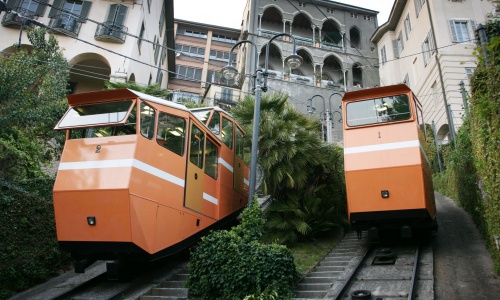
128 years old and a 52% slope for the two wagons of the funicular, connecting the two levels of Bergamo and taking us to the Old Town, where our first stopover is the Rocca stronghold, located on a panoramic hill.
The very heart of “Città Alta” is Piazza Vecchia, where we can visit the Angelo Mai Library’s Archive or climb up to the top of the Civic Tower (“Campanone”) and admire the amazing view of the city and the valleys.
128 years old and a 52% slope for the two wagons of the funicular, connecting the two levels of Bergamo and taking us to the Old Town, where our first stopover is the Rocca stronghold, located on a panoramic hill.
The very heart of “Città Alta” is Piazza Vecchia, where we can visit the Angelo Mai Library’s Archive or climb up to the top of the Civic Tower (“Campanone”) and admire the amazing view of the city and the valleys.
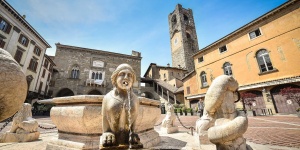
Piazza Vecchia represents the core of Città Alta: it has been the heart of political power for centuries and it keeps being one of the most popular places for Bergamo’s citizens to spend some time with friends.
Beauty is all around you if you have a seat at one of the square’s restaurants or cafes, having a drink, breakfast or even a romantic dinner. You can admire the building called “Palazzo della Ragione”, the oldest municipal seat in Lombardy, as well as the Torre Civica, a bell tower also called “Campanone”.
In the middle of the square is located the Contarini Fountain, which was donated to the city by the chief magistrate Alvise Contarini in 1780, while on the opposite side of Piazza Vecchia you can see the Palazzo Nuovo (“New Palace”), which served as Bergamo’s Town Hall until 1873 and is today the seat of the Angelo Mai Library. Its incredible collection includes ancient and precious books: incunabula, books from the 1500s, engravings, manuscripts and other inestimable artefacts making it one of the most outstanding libraries in Italy.
The geometrical layout of the buildings around the square is so harmonic that when Le Corbusier visited Bergamo he said “you can’t move a single stone, it would be a crime”
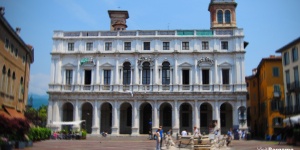
Palazzo Nuovo (“New Palace”) is like a theatre wing located in via Colleoni, overlooking the Piazza Vecchia. It’s called like that in contrast with Palazzo Vecchio (“Old Palace”) aka Palazzo della Ragione, standing in the opposite side of the square.
It took three centuries to build it: the works started in 1604 and ended in 1928. The Palace has served as Bergamo’s Town Hall for three hundred years, till 1873.
Since 1928, one of its rooms has been hosting one of Italy’s most renowned libraries, the “Civica Angelo Mai”, safeguarding parchments, incunabula, codices and precious music sheets.
Inside the Tassiana Hall, you can admire the wonderful globes by Vincenzo Maria Coronelli, cosmographer of the Venice Republic. Dating back to 1688 and 1692, they feature a 3 m circumference and are made of 50 illustrated sheets. Take a look at them: are they really different from today’s ones?
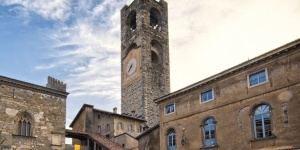
In the heart of Piazza Vecchia stands the Civic Tower, otherwise known as the Campanone, which with its height of 52.76 metres, offers a breathtaking panoramic view of the old town.
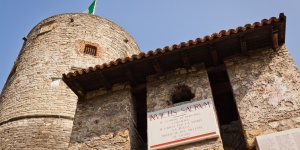
The museum is inside the Rocca, a fortress dating back to the year 1331 that really captures the essence of Bergamo’s history. You can follow the guided itinerary designed by the Museo Storico di Bergamo’s XIX century section, walking across gardens, walkways, towers and war relics.
If you go along the walkway layout, the same one walked by the guarding soldiers hundreds of years ago, the experience will be absolutely magical: a 360° panoramic tour all around the building.
With just one glance, you will enjoy the view of Città Alta, the Orobie Mountains and the entire plain.
The walk across history continues in the garden: discover the numerous relics of the two World Wars!
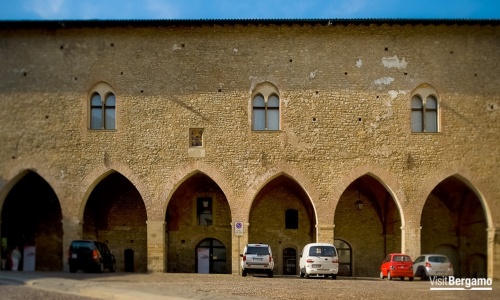
Let’s begin with the enchanting place of worship of Bergamo, with the art and architecture treasures of Sant’Alessandro Cathedral, the Cathedral’s Museum and Treasure and the Santa Maria Maggiore Basilica, then we can move to Piazza della Cittadella and enjoy an exciting journey across knowledge, thanks to the beauties of the XIV Century Palazzo Visconteo housing the Archaeology Museum and the different geologic ages of the Natural Science Museum.
Let’s begin with the enchanting place of worship of Bergamo, with the art and architecture treasures of Sant’Alessandro Cathedral, the Cathedral’s Museum and Treasure and the Santa Maria Maggiore Basilica, then we can move to Piazza della Cittadella and enjoy an exciting journey across knowledge, thanks to the beauties of the XIV Century Palazzo Visconteo housing the Archaeology Museum and the different geologic ages of the Natural Science Museum.
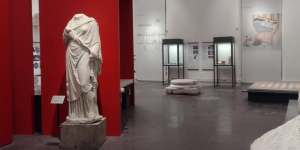
The first exhibition of the current Archaeology Museum was located in the Loggia under the Palazzo della Ragione, in Piazza Vecchia, where it was simply a “collection of old stuff” and included several epigraphs.
Since then, the collection moved several times: in fact, it required more and more space due to the conspicuous and constant donations over the centuries. Today the Museum is housed in the Cittadella Palace (XIV Century) built by the Visconti family, Milan’s ancient rulers, in a new, expanded exhibition created in occasion of Bergamo brescia Capital of Culture 2023.
Visitors can plunge into history just looking at the museum’s walls. Visiting the Archaeology Museum is like going on a journey across the history of Bergamo and its territory, from its prehistoric background to the Langobardic domination in the Middle Age.
It is very common do find groups of children and kids inside it. In fact, the “Centro Didattico-culturale”, the former “Gruppo Guide del Museo” established in 1981, contributes to give a strong educational spirit to the Museum, by carrying out many guided tours, workshops and activities for children and adults.
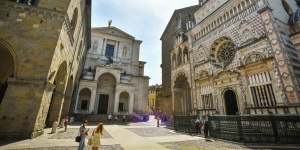
The religious heart of the city owes its name to the impressive cathedral that overlooks it, situated opposite the baptistery, the bishop's palace and the Curia.
Before the Venetian Republic created what is known today as Piazza Vecchia, this was the city’s medieval square, dedicated to St. Vincent, and the centre of the city and political life where decrees were announced, deeds were written and trades and negotiations took place.
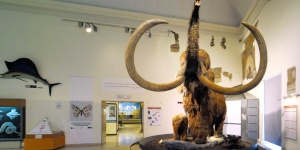
Located next to the Archaeology Museum in Piazza della Cittadella, where it was moved in the same year (1960), the Museum of Natural Science keeps most of its collections in its archives, in order to let scientists study them and develop the knowledge about environment, living animals and extinct species. It was established in 1861 in the building of Regio Istituto Tecnico: today, it hosts millions of natural findings!
Before entering the Museum, we have a little warning for you: an enormous mammoth is going to welcome you at the entrance. But don’t be afraid, it is extremely friendly!
Right after the Museum’s prehistoric guardian you will find many specimens, divided into groups: zoology, entomology, geology and palaeontology. Afterwards, you can admire many examples of all five classes of vertebrates, along with a wide and rich collection of arthropods, with more then one million specimens!
You can also admire the shimmering collection of minerals. Moreover, if you loved Jurassic Park you will also love the amazing fossils coming from Bergamo territory and from all over the world: over 55.000 findings, including a fantastic life-size cast of the skeleton of an Allosaurus, a large bipedal dinosaur!
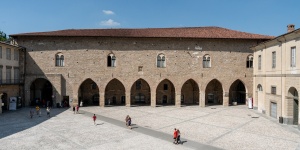
This citadel was built in the most central point of Bergamo: why? To defend the city from the enemies attacks and as a sort of garrison house in case of popular uprising, of course, but also to make sure that the subjects always remembered how powerful their rulers were: the Visconti family, head of Milan’s Duchy and Bergamo’s ruler from 1332 to 1428.
Today, this space has become a typical square in Città Alta and still hosts many traces of its past. Coming from the old town, you will walk under the Torre della Campanelle. On west, you will see a medieval postern gate: once you crossed it you’ll find a roman street (the short paved section right before the cobblestones leading to the postern gate) and you will walk under the Romanesque lowered vaults and the cylindrical pillars belonging to an ancient private house.
As soon as you’ve left the portico, you will find the La Crotta garden, a magical place full of beautiful trees, bushes and paved paths made of rectangular sandstone. The stone benches hidden among the vegetation are there for you: enjoy a romantic break!
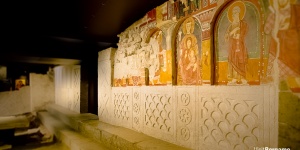
The Museum and Treasure of the Cathedral opened in 2012 under the Sant’Alessandro Cathedral. Here, during the adjustment works in 2004, several archaeological remains have been discovered, dating back to the X Century B.C. up to the XVI A.D.: prehistoric settlements, Roman domus remains, ruins of the Paleochristian church and the Romanesque cathedral.
By means of this Museum, Bergamo’s Diocese aims to disclose the church’s history, showing its building phases and let the visitor enjoy the sacred and beautiful atmosphere of the old San Vincenzo Cathedral, by displaying numerous precious items of religious art.
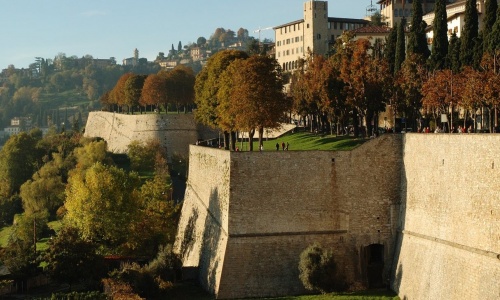
Bright green areas colour the ramparts of the ancient Venetian Walls, offering a terrific view and giving us the perfect chance to relax in nature surrounded by history and architecture gems. Here we can admire the majestic Venetian Gates, such as the stunning San Giacomo Gate and Sant’Agostino Gate, which hosts some interesting contemporary art exhibitions throughout the year. Along the Walls, the casemates of San Michele and San Giovanni are the perfect places to travel back in time: it is possible to visit them from April to October during weekends.
Bright green areas colour the ramparts of the ancient Venetian Walls, offering a terrific view and giving us the perfect chance to relax in nature surrounded by history and architecture gems. Here we can admire the majestic Venetian Gates, such as the stunning San Giacomo Gate and Sant’Agostino Gate, which hosts some interesting contemporary art exhibitions throughout the year. Along the Walls, the casemates of San Michele and San Giovanni are the perfect places to travel back in time: it is possible to visit them from April to October during weekends.
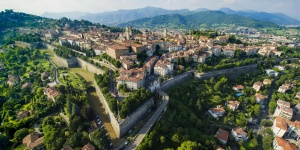
Bergamo wouldn’t be the same without its impressive Venetian Walls. This spectacular circuit is over six km long: it’s the perfect place to take a romantic walk and enjoy wonderful sunsets, and it has been enclosing the beauties of the Upper Town for more than four centuries.
The priceless artistic and cultural value of the Venetian Walls is demonstrated by their recognition as a Unesco World Heritage site.
They were built starting from 1561 by the Republic of Venice in order to face enemies attacks, but History was kind with them: maybe due to their stunning beauty, they never underwent any siege. That is why they remained almost intact to the present day.
The Walls consist of 14 bastions, 2 platforms, 100 embrasures for cannons, 2 armouries, four gates, not to mention the underground structures featuring sallies, passages and tunnels: don’t miss the chance to walk inside the Walls and to visit the casemates of San Michele and San Giovanni!
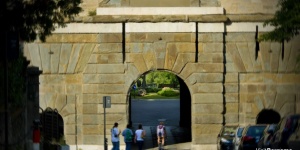
The four doors that open along the perimeter of the walls are named, except for the gate of Sant’Agostino, after neighbouring churches, demolished in order to build the walls, including the early Christian basilica of Sant’Alessandro.
The facade of the Gate of San Giacomo (1593), facing Lower Bergamo, features the lion of San Marco.
The stone bridge was built in 1780 by the Podestà Alvise Contarini.
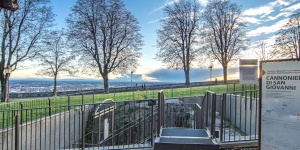
To enter the San Giovanni Casemate you have to go down a few meters under the ground by means of an iron staircase, in the rampart with the same name: this defensive structure was built right here, hundreds of years ago.
Getting to the manoeuvre area of the casemate, perfectly restored, history suddenly becomes something tangible, as you immediately understand what was war like five hundred years ago.
Casemates were used to allocate soldiers and cannons defending the city Walls. As you may notice, the embrasures don’t face the flatland: this is not a mistake, but a strategic choice! The cannons’ openings were guarded against the enemy fire, so that they could open fire to the enemy soldiers assaulting the walls.
Once you got back to surface, you will notice a particular metal object. It’s a sundial, a very ancient tool reinterpreted by using contemporary features and materials: it can almost seem an art installation, indeed!